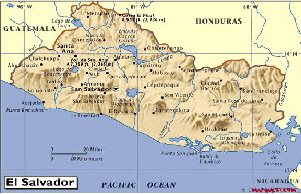

Estanzuelas
The area chosen was the district of Usulutan which was one of the most heavily hit regions during the earthquakes. The project was based in the municipality of Estanzuelas, working in conjunction with the local alcaldia (mayor's office). Estanzuelas is a relatively small town with a population of around 6000, situated around half and hours drive from the Pan American Highway, close to the Rio Lempa. Evidence of earthquake damage is still seen in the area a year later; only the facade of the church remains with a construction project ongoing to repair the remainder of the building. Services are still held under a temporary roof. The central square is currently also undergoing removation with a development to include a basketball court, a children's play area, a football pitch and a park area.

Condadillo
Construction took place in the village of Condadillo, a half hour's drive from Estanzuelas along a dirt road. It is a very small village populated by subsistence farmers and fishermen, although the fishing industry was seriously hit by a severe pollution incident in the Rio Lempa a few years ago. The village is in one of the poorest districts of Estanzuelas, with one of the highest rates of infant malnutrition.
Earthquake Damage
The first of the two earthquakes occurred on the 13th January 2001 and was the greatest magnitude registered in the country the last 100 years. Its focus was offshore but relatively deep, resulting in a large area of impact. A month later, the recovering country was hit by a second, smaller earthquake with its epicentre inland, to the east of San Salvador. 90% of the houses damaged in the earthquake are reported to have been of adobe. The earthquakes took place at 9am and 12pm respectively and as a result the death toll was relatively low; it could have been much higher if the earthquakes had taken place at night.
The community of Condadillo for the most part live in two houses. An adobe house used for cooking and daytime activities, and a metal sheeting construction where they sleep for fear of the collapse of the adobe houses; these act like an oven and are uninhabitable in the heat of the day.
A woman in Condadillo spoke of sleeping in the street for several weeks after the earthquake to avoid sleeping in her adobe house.
Adobe
Adobe is the building material most commonly used by the poorer communities of Central America. While there are many benefits of its use as a building material – it is cheap, locally available, easy to use, durable, sustainable and has a high compressive strength - there are some important disadvantages. Adobe has a low tensile and flexural strength – which makes it extremely susceptible to the lateral forces induced by earthquakes. It also has a relatively high specific mass, which attracts the earthquake forces and intensifies their effect.
However, there are simple reinforcement techniques and construction methods that can be used to increase its earthquake resistance. One of the main problems is how best to disseminate this knowledge. The people in the most isolated and remote areas of El Salvador, who most commonly use adobe, are aware of the problems relating to its use, however they have many other concerns that prevent them from making its improvement a priority. Workshops run by UCA in San Salvador were poorly attended by rural communities. The presence of a group of young students in the village acted as a catalyst for the involvement of the community in the project, enabling them to learn through their involvement about these construction techniques.
Politics
The local municipality is currently held by the FMLN, who won a closely contested election four years ago by less than a hundred votes. The alcaldia is well organised, and keen to involve overseas organisations in exchange projects. A group of ex-Dockers from Liverpool were also working in a nearby community as part of a solidarity project.